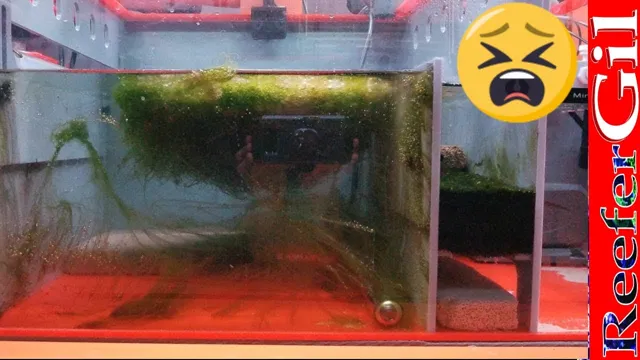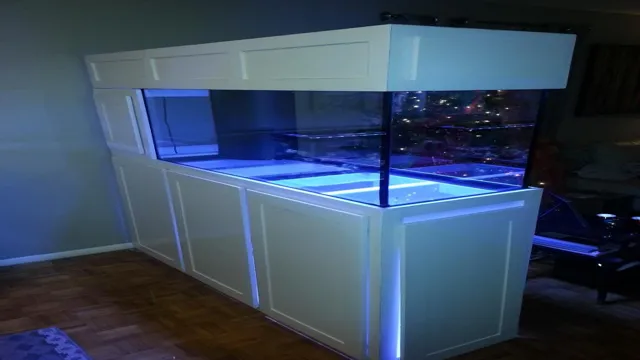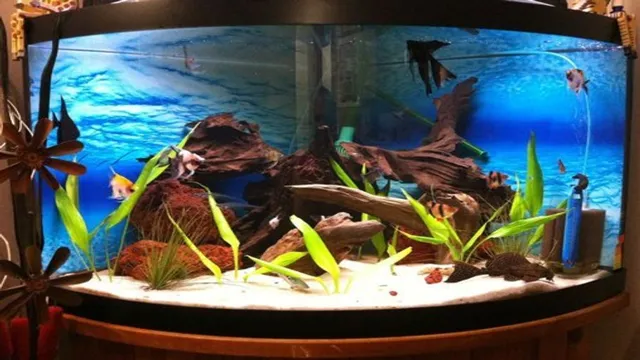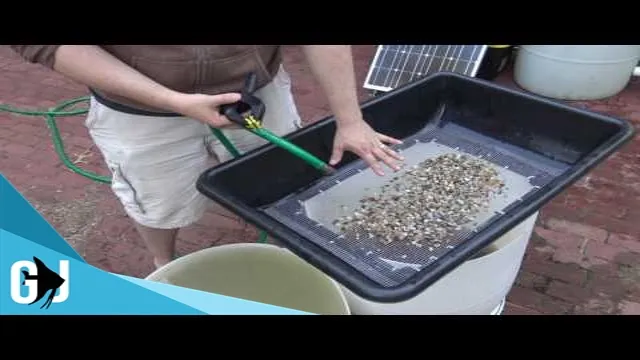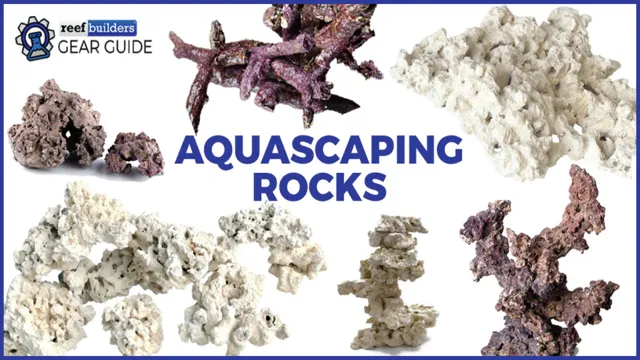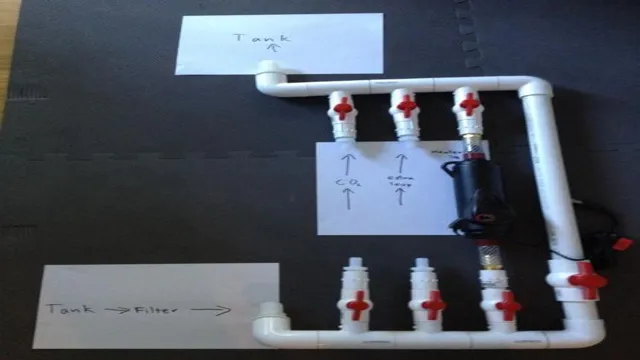Is algae taking over your aquarium? Don’t worry – you’re not alone. Many aquarium owners struggle with the nuisance of algae growth. Not only is it unsightly, but it can also harm your aquatic plants and fish.
But fear not, there are steps you can take to beat the algae and keep your aquarium clean and healthy. First, it’s important to understand what causes algae to grow in the first place. Algae thrive in environments with excess light and nutrients.
If you have too much light or are overfeeding your fish, you’re creating the perfect conditions for algae to take over. To combat algae growth, start by reducing the amount of light your aquarium receives. Consider lowering the wattage of your bulbs or reducing the amount of time they are on each day.
Be sure to also reduce the amount of food you give your fish. Overfeeding can lead to excess nutrients in the water, which, in turn, will fuel algae growth. Regular maintenance is also key.
Regular water changes and gravel vacuuming can go a long way in preventing algae from taking over. You should also consider adding live plants to your aquarium. Not only do they consume excess nutrients, but they also provide competition for the algae.
In addition to these steps, there are also chemical remedies available. Algaecides can be effective in killing off algae, but they should be used with caution as they can also harm your aquatic plants and fish. By taking these steps, you can say goodbye to algae in your aquarium and hello to a clean, healthy environment for your aquatic pets.
Understanding Algae
Dealing with excessive algae in your aquarium can be frustrating. Algae is a natural occurrence that needs some level of maintenance. Algae growth is encouraged by excess nutrients in the water like nitrates and phosphates.
To beat algae in your aquarium, start by performing partial water changes frequently. This reduces the amount of nutrients in the water. The second step is to reduce the amount of light your aquarium gets.
Algae thrive in light, so limiting the amount of it your aquarium gets will slow their growth. Lastly, cut back on feeding your fish, as uneaten food contributes to the excess nutrients in the water. It’s important to note that removing all algae is impossible, but managing its growth is key to having a healthy and beautiful aquarium.
By following these simple steps, you’ll be able to beat the algae in your aquarium and enjoy a healthy and happy aquatic environment for your fish and other aquatic inhabitants.
Types of Algae
Algae is a diverse group of photosynthetic organisms that can be found in various environments such as freshwater, saltwater, soil, and symbiotically with other organisms. They come in different shapes, sizes, and colors ranging from single-celled, filamentous, to multicellular forms. Algae play a crucial role in the aquatic ecosystem as they serve as the base of the food chain for aquatic animals and provide oxygen through photosynthesis.
Some types of algae produce harmful toxins that can cause harmful algal blooms, while others are used in the production of food, pharmaceuticals, and biofuels. Understanding the different types of algae is essential in managing their growth and impact on the environment. Green algae, blue-green algae, red algae, and brown algae are among the most common types of algae. (See Also: How Thick Should Aquarium Acrylic Be for Your Marine Life? The Ultimate Guide)
Each type has its unique characteristics, such as the type of pigments they use for photosynthesis and the habitats they thrive in. By identifying the type of algae present in a particular environment, scientists and environmentalists can make informed decisions on how to prevent or mitigate their negative impact and optimize their benefits.
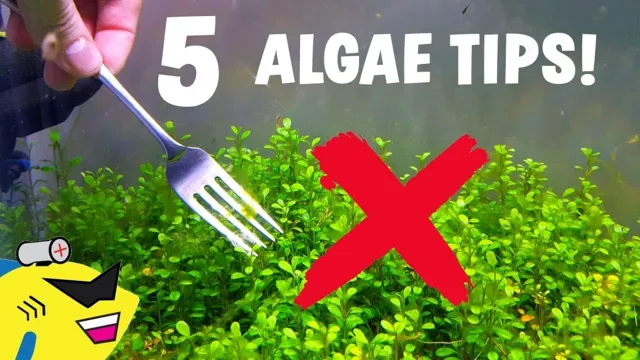
What Causes Algae Growth
Algae growth is a common problem in both freshwater and saltwater environments. Understanding what causes algae to grow is key to preventing it from taking over ponds, aquariums, and swimming pools. One of the most significant factors that contribute to algae growth is excess nutrients in the water, particularly phosphates and nitrates.
These nutrients can come from a variety of sources, including fish waste, decaying plant matter, and fertilizer runoff. Sunlight exposure is another crucial factor as it provides the energy that algae needs to grow through photosynthesis. Temperature and pH levels can also influence the growth of algae.
To combat algae growth, one effective method is to limit the amount of nutrients available in the water. This can be achieved by regular water changes, reducing the amount of food given to fish, and avoiding over-fertilizing nearby plants. Additionally, limiting sunlight exposure by providing shaded areas can also help to prevent algae growth.
However, if algae does appear, it is essential to take prompt action to prevent the problem from spiraling out of control. Vacuuming the bottom of ponds and using algae-eating fish, chemicals, or UV sterilizers in aquariums can be effective in controlling algae growth. In short, understanding the factors that contribute to algae growth and taking proactive measures to prevent it can help to keep aquatic environments healthy and balanced.
Preventing Algae Growth
When it comes to maintaining a healthy and clean aquarium, algae growth can be one of the biggest challenges. But there are several tricks to preventing and beating algae growth in your aquarium. One of the most effective methods is ensuring adequate water circulation and filtration.
This helps to prevent stagnant areas where algae can thrive. Additionally, limiting the amount of light exposure and using a timer to regulate the amount and duration of lighting can also help. Algae thrives in light, so it’s important to keep this in check.
And finally, adding algae-eating animals like snails or shrimp can help to keep algae levels in check naturally. With these tactics in place, you can enjoy a beautiful and healthy aquarium without having to worry about algae taking over.
Controlling Nutrient Levels
When it comes to preventing algae growth in your aquarium, one of the most important things you can do is control the nutrient levels in the water. Algae thrives on nutrients like nitrogen and phosphorus, which can come from fish waste, uneaten food, and decaying plant matter. To prevent these nutrients from building up, it’s important to do regular water changes and clean your aquarium substrate and decorations.
You can also use plants and algae eaters to help absorb excess nutrients and keep algae growth in check. It’s a delicate balance, but with consistent maintenance and the right tools, you can create a healthy and thriving aquarium environment. So, don’t wait until you’re dealing with a major algae outbreak – take control of your nutrient levels and keep your aquarium beautiful and balanced.
Cleaning and Maintenance
When it comes to keeping your aquarium clean and healthy, preventing algae growth is a top concern. Algae can quickly take over your tank if it’s not properly maintained, and it can negatively impact the health of your fish and other aquatic life. So what can you do to prevent algae growth? One of the best things you can do is keep your tank away from direct sunlight.
Sunlight can encourage algae growth, so placing your tank in a shaded area or using a fluorescent light instead can help to control it. Another important step is to regularly clean your tank and filter. Removing any excess waste or debris can help to reduce the likelihood of algae growth. (See Also: How to Create CO2 for Aquarium Plants: A Beginner’s Guide to Healthy Growth)
Finally, consider adding some algae-eating fish or snails to your tank. These creatures can help to control algae naturally, keeping your aquarium looking great and your aquatic life healthy. By following these tips, you can prevent algae growth and ensure that your aquarium is a beautiful and healthy environment for your fish and other aquatic pets.
Treating Algae in Your Aquarium
If you’re an aquarium owner, you’re likely aware that algae can be a major problem. But don’t worry, there are some simple steps you can take to prevent and treat algae in your aquarium. First and foremost, maintaining proper lighting and feeding schedules can help keep algae growth under control.
It’s also a good idea to regularly clean your aquarium and avoid overfeeding your fish. If algae growth does become an issue, consider using an algae scrubber or vacuum to manually remove it. Additionally, there are various chemical treatments available that can help eliminate algae, such as copper sulfate or algae control products.
However, be sure to carefully follow the instructions and dosages for any chemical treatments, as overuse can harm your aquarium and its inhabitants. With these tips and some regular maintenance, beating algae in your aquarium can be a breeze.
Removing Algae Manually
If you have an aquarium, it’s important to know how to treat algae growth. One method of removing algae is manually. You can use a small brush or sponge to scrub the walls of the aquarium where algae has grown.
Make sure to use a brush or sponge that is only used for your aquarium and not for anything else. If you have plants or decorations that have been affected by the algae, you can remove them and clean them separately. While this method may take some time and effort, it’s an effective way to control algae growth and ensure a clean and healthy environment for your aquatic pets.
Remember, prevention is key when it comes to algae growth, so make sure to regularly clean your aquarium and maintain proper filtration to avoid excessive growth. By taking care of your aquarium and implementing manual removal techniques when needed, you can keep your aquatic pets happy and healthy.
Using Chemical Treatments
Treating algae in your aquarium can be a challenging task, but using chemical treatments can help. One popular option is the use of algaecides, which are chemicals specifically designed to kill algae. These treatments come in various forms, such as liquids or tablets, and can be added directly to the water.
It’s essential to follow the instructions carefully and use the correct dosage for your aquarium size to avoid harming the fish or other aquatic life. Another treatment option is carbon dosing, which involves adding a carbon source to the water, such as vodka, to promote the growth of bacteria that consume excess nutrients, ultimately preventing algae growth. However, it’s crucial to monitor nutrient levels regularly to avoid creating an imbalance that could harm your aquarium’s inhabitants.
While chemical treatments can be effective, they should be used as a last resort after trying other natural and mechanical solutions like proper water circulation, lighting control, and regular aquarium maintenance. Remember, preventing algae growth is more manageable than treating it, so it’s vital to maintain a healthy and balanced aquarium environment.
Conclusion
In conclusion, the key to beating algae in your aquarium is to create a balanced and healthy environment for your fish and plants to thrive in. This means ensuring that your lighting, filtration, and CO2 levels are all properly calibrated, and that you’re not overfeeding or overcrowding your tank. With a little bit of patience, dedication, and some good old-fashioned elbow grease, you too can say goodbye to those pesky green invaders and enjoy a clear and vibrant aquarium full of happy fish and plants. (See Also: How to Clean Aquarium Nano Water Pump: Tips and Tricks for Crystal Clear Water)
Just remember, a little bit of prevention goes a long way – so stay on top of your water changes, keep an eye on your nutrient levels, and always be vigilant against any signs of trouble. With these tips in mind, you’ll be well on your way to beating algae and becoming a true aquarium master.”
FAQs
What causes algae in aquariums?
Algae growth in aquariums can be caused by several factors including excess light, overfeeding, lack of proper water circulation, high levels of nutrients in the water, and dirty substrate.
How can I prevent algae growth in my aquarium?
You can prevent algae growth by reducing the amount of light your aquarium receives, not overfeeding your fish, maintaining good water circulation, and cleaning your aquarium regularly.
What type of fish or snails can help control algae in aquariums?
Siamese algae eaters, amano shrimp, otocinclus catfish, and nerite snails are all known to help control algae growth in aquariums.
How can I manually remove algae from my aquarium?
You can manually remove algae from your aquarium by using an algae scraper or brush, or by performing water changes and physically removing algae from plants, decorations, and substrate.
Can I use chemicals to get rid of algae in my aquarium?
While there are chemicals available on the market that claim to remove algae from aquariums, it is not recommended as they can harm your fish and other aquatic life. It’s best to stick to natural methods of prevention and removal.
What is a good lighting schedule for my aquarium to prevent algae growth?
It’s recommended to have your aquarium lights on for 8-10 hours per day to prevent excessive algae growth. If you notice algae starting to grow, you can reduce the lighting time to 6 hours per day.
Will reducing the amount I feed my fish help prevent algae growth in my aquarium?
Yes, reducing the amount you feed your fish will help lower the amount of nutrients in the water that algae feed on. It’s also important to not let any uneaten food remain in the aquarium, as it will contribute to algae growth.

